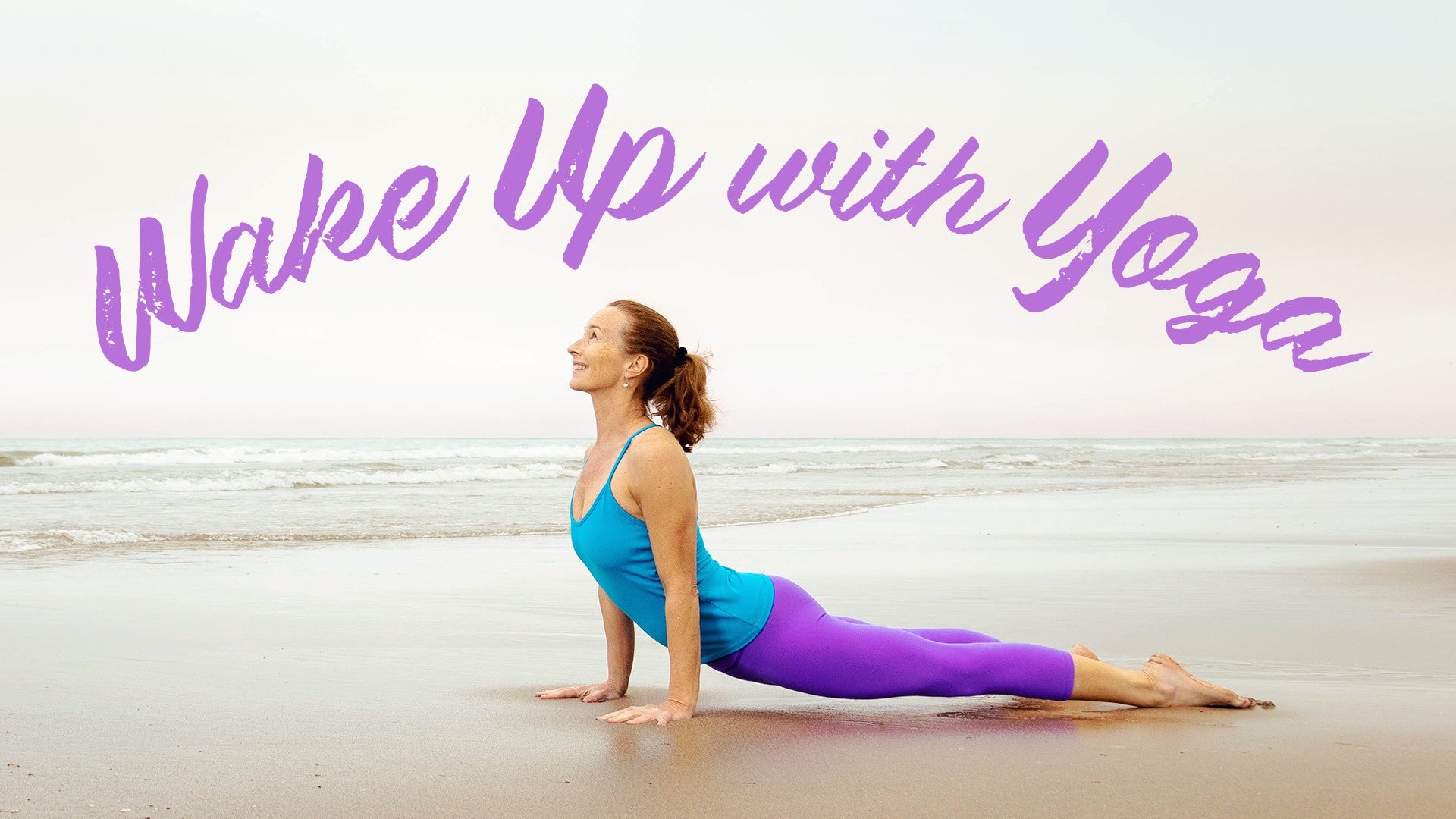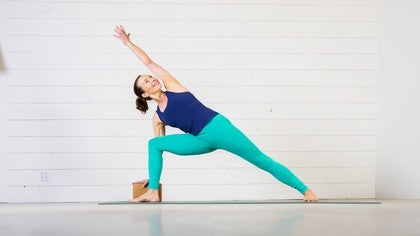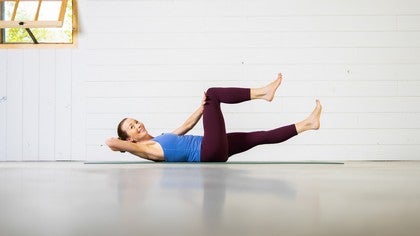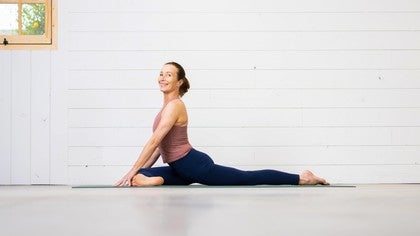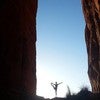Description
About This Video
Transcript
Read Full Transcript
Welcome to your practice. We will start with some gentle stretching and then move into some core work. This will be a challenging yet, I hope, fun practice. So let's get started. It will be good for you to have a couple of blocks.
So let's start lying on our backs. And start by bending your knees and half your feet about hips width. Parallel your feet, placing your hands on your belly. And then starting with some very gentle pelvic tilts, as you exhale, you're going to press your lower back into the floor. And you may feel how your abdominal muscles are doing that movement.
And then as you inhale, arching your lower back. So moving a little bit more towards your tailbone. And again, exhale, pressing your lower back into the floor. And just go back and forth a few more rounds. So inhalation to arch your lower back, exhalation to press your lower back into the floor.
So just slowly back and forth. When you're pressing your lower back into the floor, that's also called a posterior pelvic tilt. When you are kind of hyper arching your lower back, that's called an anterior pelvic tilt. And then eventually when you relax, your pelvis and spine will be more neutral. Meaning that there will be a little bit of airspace between the floor and your lower back.
Now bring your knees into your chest. And as you bring your knees into your chest, notice how your lower back will flatten on the floor. And then straighten your left leg out onto the floor as you hug your right knee into your chest. So just a couple of breaths here, just very light, gentle stretching. You can point and flex your feet.
You can make ankle circles. And then hugging both knees into your chest and straighten your right leg out onto the floor. Again, you can move your feet. You can make those ankle circles. And then eventually hugging both knees into your chest.
Bring your knees away from your chest until your spine and pelvis, they're in neutral. So you're not pressing your lower back into the floor. And placing the palms of your hands flat onto your thighs, knees and feet hips width, and flex your ankles. Then as you're pressing your hands against your thighs and your thighs against your hands, you may start to feel your abdominal muscles starting to work. So you can amp it up a little bit to work a bit harder, but you're not pressing your lower back into the floor.
Good, now see if you can make that or keep that muscular engagement. Insolace your fingers to the back of your head or cup the back of your head with your fingertips. And then as you exhale, lift your head and shoulders just a little bit off the floor, not terribly high. And then start to straighten your right leg forward, making sure that you're not moving into that anterior pelvic tilt. So keep firming your belly in.
If it for some reason doesn't feel right, it doesn't feel good, then choose to press your lower back into the floor. And then inhale, bring the knee back to center, thighs perpendicular to the floor, and then exhale, straighten your left leg forward. And you don't have to lower the left leg close to the floor. You can even raise the leg a little higher. And then inhale, knee back to center.
So we're going to add on, so as you straighten your right leg forward, take your right hand to the left thigh and press again just like you did earlier. And then inhale back to center, hands behind your head, supporting your head. Exhale, left leg forward, right hand to the right thigh, making sure that you're not aggressively pulling your head. So think more that your hand is supporting your head, head lightly pressing against the hand. And then back to center.
And then exhale, right leg extend forward, right hand to the left thigh, inhale back to center. So find your rhythm here. Straighten your left leg forward, left hand to your right thigh. Inhale back to center. So just continue this on your own.
Do it very slowly, deliberately, focusing your attention, especially on firming your belly front ribs in so that you're stabilizing your trunk as you're moving your leg, your arm. Let's just do two more rounds here. And it's really not about how many you do. It's how well you do these exercises. Moving mindfully, slowly.
And then after you've finished the round that you are at right now, hug your knees into your chest and thank yourself. And then bring your feet down, roll over onto either side and find your way onto your hands and knees for cat and cow. So when you're ready in that tabletop position, inhale, open up your chest, arching your back. And as you exhale, round your back. As you inhale, as you open your chest, as you lift your tailbone, you're back in that anterior pelvic tilt.
And then as you exhale, back to that posterior pelvic tilt, and your back is in flexion, it's rounded. And as you inhale and you're arching your back, your spine is in what we call extension. So just one more round here. And then eventually finding a more neutral position so that your back looks rather flat. Firm your belly, front ribs in.
Then shifting the weight into your left hand, reach your right arm forward as if you're shaking someone's hand. Stabilize your trunk by firming your belly, front ribs up. And then add your left leg. So lift your left leg until it's about parallel to the floor and notice a tendency to dip into the low back to move into that anterior pelvic tilt. So strongly firm your belly, front ribs up and hug the outer right hip in.
Just one more breath here. Push the floor away from you with the left hand and then back to all fours. And then reach your left arm forward as if you're shaking someone's hand. Push the ground away from you with your right hand. Firm your belly, front ribs in.
And then add your right leg. So again, you're stabilizing your trunk by firming your belly, front ribs up towards your back body, hugging the outer left hip in for two more breaths. This pose looks deceptively easy, but it's a lot of work. I'm sure you're feeling it. And then back to all fours.
Walk your hands forward a couple of inches and then find your way into Downward Facing Dog. And first Down Dog, you may just wanna pedal your feet a little bit. Mm, say good morning to your calf muscles, your hamstrings. And then we're gonna do a little bit more core work. So as you inhale, come forward into Plank Pose.
Check that your wrists are beneath your shoulders. Push the ground away from you and reach your sternum forward. So same thing here, firm your belly, front ribs up, and then start to lift your right foot just a few inches off the floor. But as you lift the foot, keep firming your belly in. And then bring your right knee to your chest.
Look a little bit in front of your hands. And then inhale, Three-Legged Down Dog. And then as you exhale, right knee to your left elbow. Pause. Inhale, Three-Legged Down Dog.
Exhale, right knee to your right tricep. Pause here for a moment, and then place the foot to the outside of your right hand. And we'll just pause here in Lizard Pose. But just another four to five breaths, pressing your left thigh bone up towards the ceiling, sinking your hips down. Couple more breaths.
And then when you're ready, step back into Down Dog. And inhale, Plank Pose. So firm your belly, front ribs strongly up towards your back body. Look about a foot or so in front of your fingertips. Lift your left foot.
Bring the left knee to your chest. Pause here for a breath or two. And inhale, Three-Legged Down Dog. And exhale, left knee to your right elbow, maybe touch. Inhale, Three-Legged Down Dog.
Exhale, knee to the left tricep. Pause. And place the foot to the outside of your left hand. And pausing your left knee to the left tricep. To the outside of your left hand, and pausing here in Lizard for about four to five breaths.
Pressing your right thigh bone strongly up towards the ceiling, squeezing your hips down. So just a couple more breaths here. Find your way back into Down Dog. And then inhale, Plank Pose. Exhale, slowly lower down.
See if you can land in one piece. And then inhale, either Cobra or Up Dog. See what feels right for you at this moment. And then exhale, Down Dog. And then just simply walk your feet up to your hands.
Coming to the top of your mat, feel free to work with your feet hips width, or work with your feet together. See what works better for your body. And then inhale, Ardha Uttanasana. Reach your sternum away from your navel. Exhale, bow.
Inhale, spread your arms out to the side, lifting all the way up. And exhale, hands to your heart. And just take a moment, maybe close your eyes, but take a moment to connect with your breath. Finding that pause, that stillness, and then moving from that place into Surya Namaskar B, Sensayutation B. So lower your arms, inhale, bring your arms overhead, coming into Utkatasana, Chair Pose, shifting more weight into your heels.
Notice the tendency to move into that anterior pelvic tilt, sticking the tailbone back, so see if you can curl it under. Firm your belly, front ribs in. Take one more deep full breath in, and then exhale, fold Uttanasana. Inhale, open your chest. Exhale, step into Plank Pose.
Slowly lower either all the way down or Chaturanga. Inhale, Cobra or Up Dog. Exhale, Down Dog. Inhale, leading with the inseam of the right leg, reach your right leg behind you. Exhale, step your right foot up between your hands, pivot the back heel down.
Inhale, Virabhadrasana, one. Exhale, back to Plank Pose. Lower down, perhaps all the way. Inhale, Cobra, or you could choose Up Dog. Exhale, Down Dog.
You can always skip the vinyasa. Inhale, leading with the inseam of the left leg, reach your left leg up. Exhale, step the foot through. Inhale, Warrior I. Take your time.
Exhale, back to Plank. Lower. Inhale, Cobra or Up Dog. Exhale, Down Dog for about five breaths. Shifting a little bit more weight into your fingers.
Lengthening your tailbone away from the crown of your head. Bottom of your next exhalation, either step or lightly hop your feet up between your hands. Inhale, open your heart. Exhale, bow. Inhale, Utkatasana, Chair Pose.
Exhale, Samasthiti. One more time, maybe allow your eyes to close. Connect with your breath. Allow your eyes to open. Lower your arms.
Inhale, Utkatasana, Chair Pose. Exhale, Uttanasana, Forward Fold. Inhale, Ardha Uttanasana. Open, lengthen. Exhale, step back.
Maybe use that exhalation to lower. Inhale, Cobra or Up Dog. Exhale, Down Dog. Inhale, raise your right leg behind you. Exhale, step it through.
Inhale, Warrior Once, and my pace is to suggestion. Exhale, Chaturanga. Inhale, Up Dog or Cobra. Exhale, Down Dog. Inhale, raise your left leg.
Exhale, step it through. Inhale, Virabhadrasana, one. Exhale, back to Plank. You could skip the Vinyasa or slowly go through the Vinyasa. And we meet in Downward-Facing Dog.
Five breaths. Deepening your inhalations. Lengthening your exhalations. Now, we're going to play a little bit with this sequence here in Surinamma's Guard B. And this is really about balance.
So let's just take it one step at a time. Inhale, raise your right leg behind you. Exhale, step your right foot up between your hands. Now, this time you're gonna stay onto the ball of the left foot and bring your arms out to the side like giant wings. Now, hands can also go to your hips, little easier to balance.
So keep that in mind, you're welcome to do that. Keep hugging the outer right hip in. Firm your belly, front ribs up. You stabilize your trunk and really get a sense of standing on that right foot. Spread your toes and then step your hips up.
Spread your toes and then step your left foot through. Standing, balancing on your right foot. Raise your arms overhead. Tendency here is to hyper sway your back. So firm your belly, front ribs in.
Keep hugging the outer right hip in. Hands can stay on your hips if that is easier for you. Two more breaths. Find a steady point you can softly gaze at. Now bring your hands together in front of your chest or keep your hands on your hips.
Coming into a one-legged chair. So bending your right knee, shift more weight into your right heel and then create a little bit of flexion for the lower back just to find the abdominal muscles engaging. And then kind of shoot that left leg, left foot back as you transition into warrior three. Now you're welcome to use blocks underneath your hands, highest position. I like to keep a little bend in that right knee to more easily firm the outer right hip in.
Spin the left inner thigh up towards the ceiling. Gently hug your belly, front ribs in. Take any arm, very able to bend your knee. Any arm variation here that you like that inspires you. Take one more deep full breath in and then exhale.
Reach the left foot way, way back and then you're in warrior one which suddenly feels so much easier. And then exhale, bring your hands down. Shorten the stance about half of a foot and straighten your right leg. Fold over your right leg. Feel free to use blocks underneath your hands.
Feel free to bend the right knee a little bit. Press more strongly through the ball of the front foot and firm your thigh muscles. Some of you may like to walk your hands forward. So just a few more breaths here to give your hamstrings a good stretch. And then step into down dog.
Inhale, plank. Exhale, lower all the way down. Interlace your fingers behind your back and lift your chest. So a nice counter stretch for your shoulders. Place your hands by your lower ribs, either deep in the cobra or upward facing dog.
Exhale, downward facing dog. Inhale, raise your left leg behind you. Exhale, step the foot through. Stay up onto the ball of the back foot. Either bring your hands to your hips or stretch your arms out to the side.
Hug the outer left hip in. Press your right thigh bone up. Inhale, firm your belly, front ribs up. One more breath. Get a sense of standing on that left foot as you step the right foot through and you can take your arms overhead.
Firm your belly, front ribs towards your back body just like you did in a lot of poses today. Stabilize your trunk. Find a steady point you can softly gaze at and then hands to Anjali Mudra or hands to your hips. Coming into a one-legged chair. Parallel your thighs, more weight in that left heel.
Draw your navel in. And then transition into warrior three. Again, feel free to use blocks underneath your hands. Put a little bend in that left knee to more easily firm the outer left hip in. Spin the right inner thigh up towards the ceiling.
Take any arm variation that you like. One more breath. Ooh, I feel this. Coming into warrior one. It's such a potent pose.
And then exhale, bring your hands down. Slide the left foot back, about half of a foot, and stretch over your left leg. So pausing here for another four breaths or so, pressing more strongly through the ball of the front foot as you firm your left thigh muscles. Find your way into downward-facing dog. Last time, you inhale, plank.
Exhale, lower all the way down. Interlace your fingers, the non-habitual way behind your back. Lifting up. So just a couple more breaths here. And then exhale, bring your hands down.
So just a couple more breaths here. Spin the inner thighs up towards the ceiling and the action of that posterior pelvic tilt, curl your tailbone under. And then hands by your lower ribs. Inhale, pick the back bend that works best for you. Exhale, down dog.
And then please, coming onto your knees, come into child's pose. Pause. Rest. Breathe. And then slowly sitting up and move your hips to one side.
You're going to lie down on your back, half your blocks close to you so that you don't have to turn your head in a moment and look for them. And so when you're ready, coming onto your back. Half your feet about hips width. Parallel your feet. If you have a ponytail where you're right onto that, you know, band, that elastic, go ahead and either get rid of the ponytail or just kind of move it like I did.
Minor, interesting advice. Okay, so go ahead and do robot arms here. Pressing your elbows into the floor, see if you can lift your chest and just wiggle the shoulders under a little bit. And then you have this sway back position, so see if you can lengthen your tailbone forward and up so that posterior pelvic tilt. Feet about hips width, parallel your feet.
And then slowly leading with your tailbone, start to lift up into bridge pose. Maybe you can wiggle the shoulders under just a little bit more. Welcome to interlace your fingers, but if your pec muscles are tight, your chest muscles are tight, grab hold of the sidelines of the mat or stay with robot arms. Now coming up onto the ball of each foot and especially pressing through the mounds of your big toes, spin the inner thighs down and then lengthen your tailbone forward and up. Better in this position not to turn your head.
So just a couple more breaths here. Preferably without turning your head, you're going to now find your block or blocks. It's better to use firm blocks here. And you can either stack them on top of one another or side by side. You can figure out the height that works best for you.
So if you haven't done this before and you need to have a look, I would come out of the pose and just look, right? So make sure that the support is underneath the back of your pelvis, not your lower back. It should feel good, right? The height is not important. Many times just simply stack the blocks or use one block, but it's really about what feels right for your body.
Now you could stay here in supported bridge pose. You could also explore stretching your legs up, viparita karani. Now, if your hamstrings are tight, what will typically happen is that you'll roll off the blocks. All you need to do is bend your knees to shift the weight into the back of your pelvis. Now continue pressing your shoulders and arm bones into the floor to keep a nice lift in your chest.
Soften your throat, soften the space between your eyebrows. This is a wonderful pose to calm your nervous system. In many ways, it's quite similar to shoulder stand, but it's a lot easier on your neck, easier for most people to get into as well. We'll stay here for about another five, for about another five breaths. Again, your eyes can be closed.
Smoothing out your breath. And let's transition out of this pose slowly. So one foot at a time, bring your feet down. So transitions are important. Just like in life, lift your heels again to lift your hips and then move the support out of the way.
And then stay up onto the ball of each foot. Reach your arms behind your head and then just very slowly, one vertebra at a time, lower back down. See if you can lower your lower back down before the back of your pelvis. And then whenever you're back down, bring your arms out to the side like cactus arms. Take a breath or two here and then cross your ankles, gently hug your knees into your chest.
Change the crossing of your ankles. Make circles up on the ceiling with your knees. Massage the area around your sacrum. And then eventually finding your way into Shavasana. If you have some extra time, it's not a bad idea to do threat the needle pose, maybe a gentle, simple twist, but for sure, if you have time, if you can take a moment to simply be sensing your breath, your body on the floor, this moment.
And of course, you can stay in this position as long as you can, as long as you want to. It's a great way to meditate unless you have a tendency to fall asleep. If you're ready to come out of the pose, you can place your hands on your belly or chest. Just take a moment to center yourself, connecting with your body again, bending your knees, and then rolling over onto either side and find your way back to a comfortable seat. Thank you so much for joining me in this practice.
I wish you a wonderful day. Namaste.
Wake Up with Yoga: Birgitte Kristen
Comments
You need to be a subscriber to post a comment.
Please Log In or Create an Account to start your free trial.
